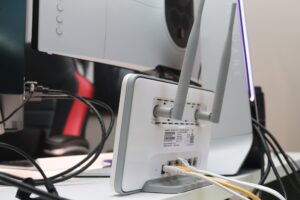
How WiFi Automation Complements WiFi Management for Enterprise Networks

Enterprise WiFi networks are complex. From the initial design and site survey to implementation and upgrades, limiting the number of times someone asks, “Why is the WiFi slow?” requires IT professionals to pay constant attention to a network ecosystem’s performance, behavior, reliability, and availability.
This means that IT teams need 24/7 data analytics. There are a number of different tools and best practices in place to support the analytic process and network optimization, including WiFi management and WiFi automation platforms. Read on to discover how these platforms complement each other and why both are needed for WiFi assurance.
What is WiFi automation?
You’re likely familiar with APs and their respective WiFi management systems, but you might not know what to expect from WiFi automation. So, first things first, what are these platforms?
As you would expect from the name, they automate the analytics side of network optimization. This is a significant time saver for enterprise IT teams that are responsible for networks with up to thousands of APs and connected devices. These devices generate tens of thousands of data packets per second, making it impossible for human teams to analyze network behavior in real-time. With automation platforms, teams don’t have to worry. Analytics and optimization best practices are delivered in real-time, any time.
What do enterprises need from these platforms?
Network optimization consists of management+troubleshooting+future-proofing. Management and automation platforms need to provide these three pieces for enterprises to experience the best ROI.
This ROI is determined by evaluating business productivity and continuity before and after the adoption of the technologies.
Complete network visibility
Safeguarding business continuity is impossible without complete visibility into the entire network ecosystem. This includes:
- Everything that defines the network: all connected devices, backend and frontend infrastructure, applications, software, etc.
- Everything that affects the network: all of the above, as well as WiFi and non-WiFi sources of interference such as nearby networks, Bluetooth devices, Microwaves, and more.
IT teams need to know exactly what is happening on and to the RF environment that an enterprise network operates within. Here’s how the two types of platforms work together to provide this visibility 24/7 for WiFi assurance:
- WiFi management: these platforms are designed to have a centralized focus on enterprise network infrastructure. If a device is connected to the network, this platform makes sure IT knows it and how it is operating
- WiFi automation: these platforms take a wider view, providing insight into the core WiFi network as well as into the entire RF environment, ensuring that IT knows about sources of interference that lie outside the network. They also can be vendor agnostic, which allows them to be used at all enterprise sites, and to continue providing complete visibility even if WiFi vendors change.
One or both of the platforms should be a multi-radio solution so that both the 2.4GHz and 5GHz frequencies are monitored/analyzed at all times, even while network tests are run.
Network troubleshooting
Sooner or later, there are going to be problems. Enterprises need processes in place to quickly resolve issues and minimize the negative impact on the user experience.
- WiFi management: these platforms can check for problems currently on the network and alert IT to issues. This may or may not require manual input.
- WiFi automation: some platforms, if powered by AI, will learn to recognize normal and abnormal network ecosystem behavior and automatically alert teams to any current or potential issues; alerts can include root-cause identification and actionable resolutions so that issues can often be resolved before end users are affected.
Network testing
Proactive network optimization allows teams to respond to issues as soon as they occur. To achieve this, IT professionals either need to be able to schedule tests to run automatically, or they need to manually run tests at designated times. This should include all hours of the day, even if no one is onsite.
The complementary benefits of WiFi management and automation platforms here will depend on the specific features of the chosen platform. Enterprises should look for solutions that provide:
- Automatic alerts to any failed test
- Tests that reflect the end user perspective – i.e. from a platform that can connect to the network as an end user device
- A platform that will provide consistent test analytics without interrupting network monitoring analytics
Remote access
Ideally, remote monitoring is something that both platforms will provide. Without it, IT professionals are forced to travel to the location of a WiFi issue before they can identify the problem, troubleshoot, and implement a resolution. This might require teams to travel down 5 floors, drive across town, or head to a remote offsite location. The longer the travel, the longer an issue will persist and affect business continuity.
Enterprises need platforms that provide remote visibility and troubleshooting. Remember, management platforms often only focus on core infrastructure, while automation platforms also look at the wider RF environment. Issues will lie within both fields, making it important for IT teams to have remote access into both.
Historical wireless analytics
Complex environments create complex issues. For this reason, it’s important for enterprise teams to have the ability to review historical wireless analytics at all times. This allows teams to know:
- Everything that was happening on a network at the time of an alert
- Long-term network health trends, which support cost-effective upgrades and updates
The Wireless Intelligence Platform™ (WIP) is the only WiFi automation solution on the market that automatically saves historical wireless traces, giving IT the ability to review packet data from any point over the last day, week, or month.
Choosing the right platforms for your enterprise
More data might not always be better, but smarter data is. Use these tips to find the WiFi management and WiFi automation platforms that will improve your enterprise’s business productivity, the user experience, and reputation.
Work with WIP for:
- 90% faster Mean-Time-to-Resolution
- 70% fewer WiFi problem tickets
- 80% fewer remote site visits


